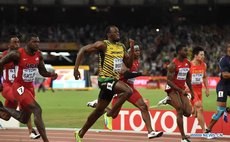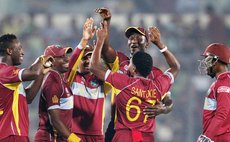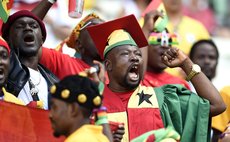Let there be light
Australia versus New Zealand third Test match at Adelaide, which went on for three days starting on 26th November, 2015, has gone into history as the first ever day-night Test. Previously all Tests were played in daylight, with more recently some provision made to allow floodlights to be utilized during closing hours of play, where necessary. As an aid to visibility a pink ball was used at Adelaide instead of the regular red, and from all accounts the innovation went down quite well. All told, upward of 120,000 match tickets were sold and used on the three days of play – probably reaching near record gate revenues for such an event. Mundane or trite as they may sound, I can't resist mentioning some barely incidental matters relating to the light factor in sports in general.
I commence with cricket. The story goes that Lord Hawke was batting for Yorkshire against Lancashire in the intense rivalry of those days of about 100 year ago in the English Country Cricket programme. Things went badly for Yorkshire during a phase of very poor light. Hawke appealed for light but the umpires resisted. Another wicket fell and Hawke utilized his last remaining appeal but to no avail. Another wicket fell but Hawke cunningly and loudly voiced an engaging enquiry to the incoming batsman: "Can you see?" To which the cryptic reply was intoned: "I can hear Thee Lord, but where art Thou?" We are not favoured with outcome beyond this point, but the whole thing was illustrative of the time when cricket was indeed a gentleman's game.
Turning to football, we had a case in the seventies when a referee at Windsor Park, happened to have been a magistrate hailing from Grenada, carried a first division match well beyond normal visibility. Thereupon the Spartans defender Clancy Casimir muttered "I cannot fu..ing see!" Normally the referee in question had maintained a severe reputation for coming down hard on expletives. However, he saw humour in the situation by responding candidly to Casimir – "me, too!" He was only going by match time on his watch!
Advancing the case further for floodlighting at Windsor Park must go to Mr. Clayton Munro. In fact he definitely takes the cake. He carried the whistle in a match involving Celtics and some other worthy opponents. From my recollection it was December month and six O'clock had long since come and gone unnoticed by Munro. It eventually reached a stage when all houses distantly adjacent to the park had resorted to their nightly illumination and so had all vehicle drivers commuting in the vicinity of the ground. Play went on and on, aided no doubt by the fact that the ball was white in colour. Munro, seemingly intent on going for a qualification of the match as a night fixture, finally conceded optical exhaustion – but not before several players had mistakenly collided with his person clad in all black referee's outfit.
It is to be noted the sports of netball and basketball had locally resorted to floodlighting even before the Munro episode in football. The first person to attempt to use artificial lighting in Dominica for an outdoor sporting event was Mr. Cecil "Thule" Burton for a netball demonstration on the Union Club grounds where now the Dominica Infirmary is located.
The historic Adelaide day-night Test came about principally for economic reasons – a means to counter declining attendances at Test matches and to secure improved public focus against the more sweeping favour accorded to one day matches, much of which have reaped benefit from night time play. All commentaries and player reports point to the event as highly successful. Players and crowds reveled in the starkly competitive nature of the unfolding. Then, too, there must have been great satisfaction with the bottom line – money coming in all told. Admission of 120, 000 at around $40 each translates into $4.8 million in Australian currency. Apart from this there would be the extremely lucrative pay per view income from no less than five million at US30 for the three day package – a hefty $150 million.
Resonating out of this we can hear a few notable players revisiting their decisions they took to retire from Test cricket ostensibly because of its greater duration. There is, indeed, nothing about the inconvenience of an extended and protracted playing time that cannot be mitigated by elevated pay increases. On top of this, night play brings with it somewhat more congenial air temperatures and escape from unwanted solar radiation.
Our account of the Test match itself we do not relegate to a footnote status. From my point of view it contained everything to class it as enthralling. New Zealand won the toss and batted, knowing full well they had to win to tie the 3-match series, having lost the first Test and drawn the second. The idea was to use up the day portion of play, and if they were bowled out cheaply, utilize the night portion to psychological effect with their tight pace bowling supported by excellent slip fielding.
After four overs New Zealand lost Guptil to Hazelwood on the grassy surface friendly to the seam bowlers. A partial recovery was halted at 59 for 2 with Kane Williamson going LBW for 22 to Starc. The tea break – now the first interval because of the modified time schedule – was taken with the Kiwis at 80 for 2, but thereafter wickets fell fairly regularly and the innings folded at 202 in 65.2 overs. Not particularly auspicious except for Stantner's debut which revealed him to be a highly promising left hander in making an attractive 31. Latham was the top scorer with 50.
Any hope that Australia would pose a characteristically solid response was quickly smothered as a wicket fell at 16 when Warner succumbed for 14, caught at slip driving off Trent Boult. Stumps on the first day with their score on 54 for 2, things favoured Australia. But that was to ignore the pressures of the situation. Shaun Marsh was run out while batting with his skipper Steve Smith – the result of a brilliant bit of fielding by Brendan McCullum to make it 67 for 4 which became 80 for 5, 109 for 6, 109 for 7 and then 116 for 8.
Hereupon ensued the incident which will be talked about till the end of time. Nathan Lyon at No. 10 swept at one cannoning off his forearm and chest to be caught in the infield. Most commentators suggested the ball had initially come off the back of the bat. After very extensive review the summation of the television umpire was that there was no evidence to indicate Lyon had played the ball. This gave way to a pugnacious 9th wicket partnership of 74 between Peter Nevill, 66 and Lyon, 34, along with a blustering 24 not out by Starc lifting the score to 224 and a lead of 22 for Australia.
New Zealand never really got to grips with improving in their second innings and were dismissed for 208 in 62.5 overs, setting Australia a target of 187. The pendulum of the match swung several more times and New Zealand had a good look in with Australia faltering on 115 for 4. All this was smoothed out by the Brothers Marsh.
Shawn, left handed and the more watchful, posted 49 before going at 176 for 6, and Mitchell, 28, saw the score to relative safety. Australia won by 3 wickets despite the worry of Starc having to come out nursing the impediment of a fractured foot.
Man of the Match was Australia's Josh Hazelwood who took nine wickets in the match. Man of the series was David Warner whose three centuries with an aggregate of 592 laid foundation for Australia's triumph 2-nil. Australia takes on the West Indies commencing at Hobart on 9th December.




